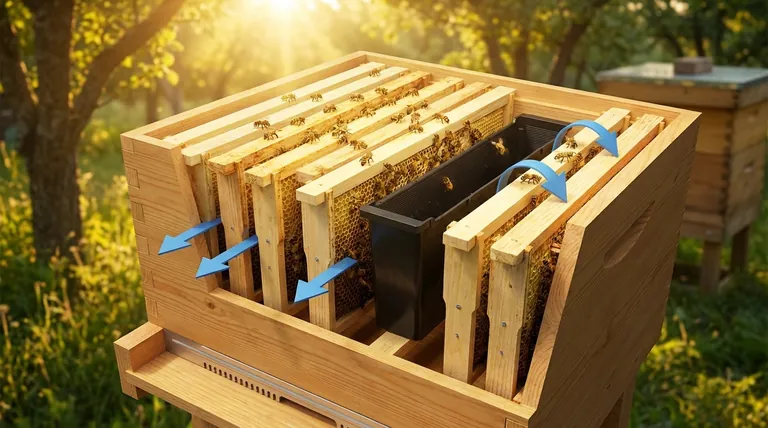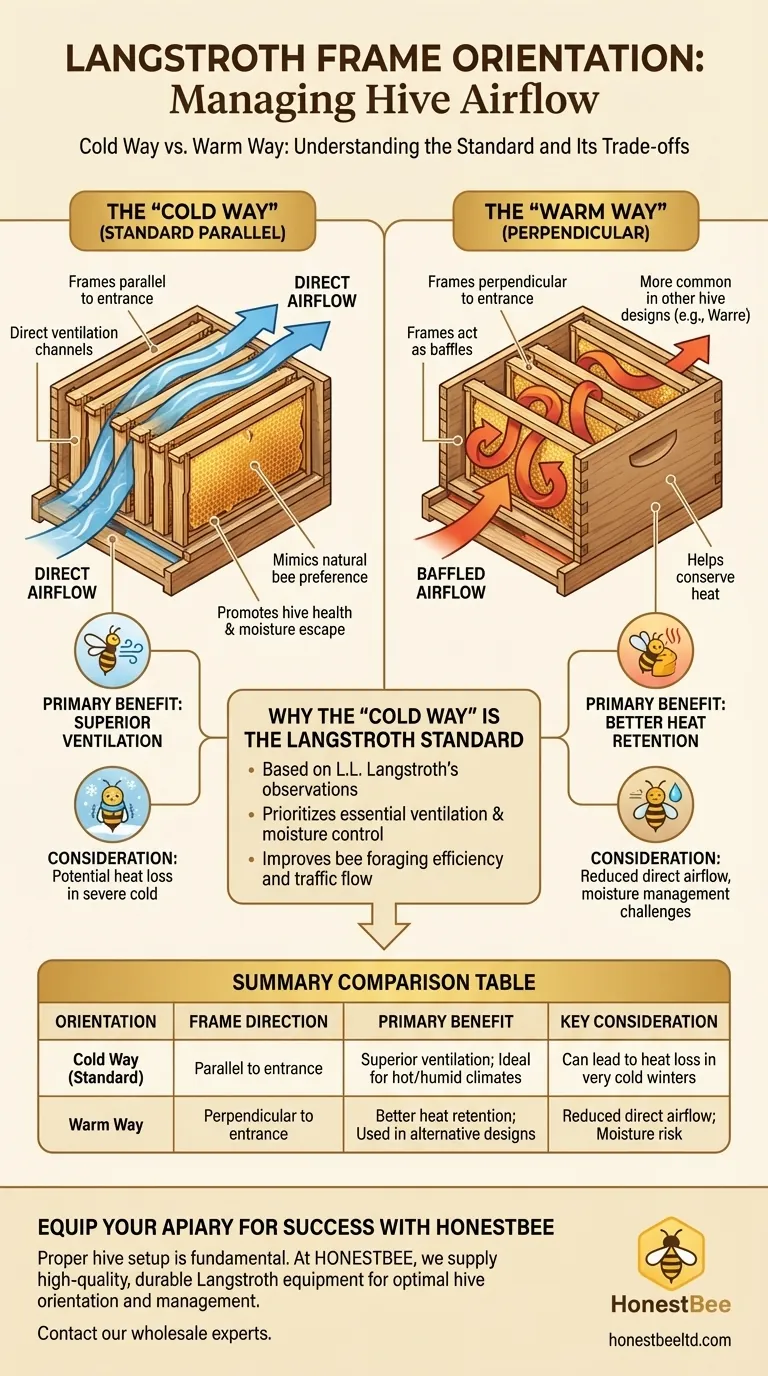By default, Langstroth hive frames are oriented "the cold way." This means the frames are positioned parallel to the hive entrance, creating direct channels from the front to the back of the hive. This design choice was based on L.L. Langstroth's observations of how bees naturally build comb, and it facilitates direct airflow through the hive.
The core decision behind frame orientation is managing airflow. Langstroth hives prioritize ventilation by running frames parallel to the entrance ("cold way"), while other hive designs sometimes run them perpendicular ("warm way") to conserve heat, each with distinct trade-offs for the colony.

Defining Hive Orientation: "Cold Way" vs. "Warm Way"
The terms "cold way" and "warm way" simply describe the relationship between the frames and the hive entrance. Understanding this distinction is key to understanding hive thermodynamics and bee behavior.
The "Cold Way" (Parallel Orientation)
The "cold way" is the standard orientation in a Langstroth hive. The frames run parallel to the entrance, front-to-back.
Imagine the spaces between the frames as long, straight corridors. Air entering the hive can flow directly down these corridors.
This creates more direct ventilation throughout the brood chamber, giving bees clear paths from the entrance to any comb.
The "Warm Way" (Perpendicular Orientation)
In a "warm way" setup, the frames are oriented perpendicular to the entrance. The first frame acts as a solid wall, or baffle, to the incoming air.
This forces air to move up and over the frames rather than straight through them.
Proponents of this method believe it helps the colony conserve heat, as direct drafts are minimized. This orientation is more common in hive types like the Warre hive.
Why the "Cold Way" Became the Langstroth Standard
The choice for the Langstroth hive wasn't arbitrary. It was a deliberate design decision based on observation and a focus on hive health and management.
Mimicking Natural Preference
Rev. L.L. Langstroth observed that when given a choice in a simple box hive, bees tended to build their combs in line with the entrance.
The "cold way" orientation was chosen to align with this perceived natural preference, providing a structure that mirrored how bees might build in the wild.
Promoting Ventilation and Hive Health
The direct channels of a "cold way" setup allow for superior air circulation.
Good ventilation is critical for a healthy hive. It helps bees manage temperature in the summer and, more importantly, allows moisture to escape during the winter, preventing condensation and mold.
Improving Bee Access and Efficiency
This orientation provides bees with a straight, unimpeded path from the entrance to the honeycomb on any frame.
This can improve the efficiency of foraging bees bringing back nectar and pollen, and it simplifies traffic flow within the hive.
Understanding the Trade-offs
Neither orientation is universally perfect. The standard "cold way" has clear advantages that led to its adoption, but it also has potential downsides depending on your climate and beekeeping philosophy.
"Cold Way" Advantages
The primary benefit is superior ventilation. In hot or humid climates, this is a significant advantage for preventing the hive from overheating and reducing the risk of fungal diseases like chalkbrood.
"Cold Way" Disadvantages
The main drawback is implied in the name. The direct airflow can lead to greater heat loss, which can be a challenge for colonies in regions with long, harsh winters. The cluster may need to consume more honey stores to generate the heat needed to survive.
Why "Warm Way" Is Used
Beekeepers who use a "warm way" orientation do so primarily for winter insulation. By disrupting the direct airflow, the hive theoretically retains more of the heat generated by the winter cluster, potentially improving survival rates in cold climates.
Making the Right Choice for Your Goal
For users of standard Langstroth equipment, the decision is largely made for you. However, understanding the principles helps you manage your hives more effectively.
- If your primary focus is following a proven, standard system: Stick with the default "cold way" orientation. It is the most widely used and documented method for Langstroth beekeeping.
- If you are beekeeping in a hot or humid climate: The "cold way" is ideal. Its emphasis on ventilation is a significant asset in managing hive temperature and moisture.
- If you are concerned about extreme winter conditions: Rather than changing orientation, most Langstroth beekeepers address this by using hive wraps, insulation boards, or ventilation quilts to help the colony manage heat and moisture.
Ultimately, knowing why your frames are oriented the "cold way" empowers you to better manage your hive's internal environment for year-round success.
Summary Table:
| Orientation | Frame Direction | Primary Benefit | Key Consideration |
|---|---|---|---|
| Cold Way (Standard) | Parallel to entrance | Superior ventilation; ideal for hot/humid climates | Can lead to heat loss in very cold winters |
| Warm Way | Perpendicular to entrance | Better heat retention; used in some alternative hive designs | Reduced direct airflow |
Ensure your apiary is equipped for success. Proper hive setup is fundamental to colony health and honey production. At HONESTBEE, we supply commercial apiaries and beekeeping equipment distributors with the high-quality, durable Langstroth equipment needed to support optimal hive orientation and management. Let us help you build a stronger, more productive operation.
Contact our wholesale experts today to discuss your equipment needs.
Visual Guide

Related Products
- Professional In-Hive Bee Feeder HONESTBEE Frame for Beekeeping
- Professional Bee Frame Wiring Tool with Integrated Tensioning System by HONESTBEE
- HONESTBEE Wired and Assembled Wooden Bee Frames Foundation for a Thriving Hive
- Stainless Steel 9 Frame Hive Spacer Durable Precise for Commercial Beekeeping
- Assembled Wooden Bee Frames with Beeswax Foundation Ready to Use by HONESTBEE
People Also Ask
- What are the standard dimensions for Langstroth beehive frames? Choose the Right Size for Your Apiary
- Are frame feeders good? Maximize Your Hive's Health with the Right Feeding Strategy
- What are the two most popular types of honey bee feeders? A Guide to Frame and Bucket Feeders
- How do you feed bees outside the hive? Understanding the Risks and Safe Alternatives
- What is a frame feeder and how does it work? An Efficient In-Hive Feeding Solution



















